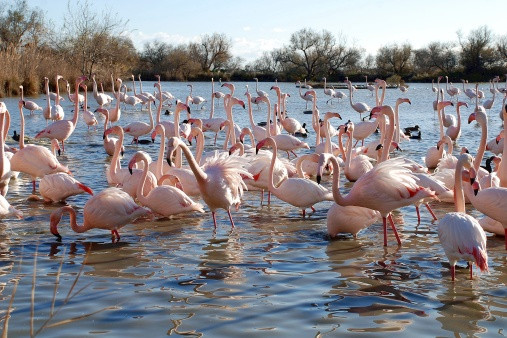To get sex, flamingos rely on elaborate flirting
Flamingos who perform the most complex sexual displays are more likely to breed.

Flamingos perform complex sexual displays to attract a partner, with greater complexity associated with a higher probability of breeding, a study has shown. Complex displays potentially signalled higher individual quality – and in particular a superior competitive ability to secure a nest site on a crowded breeding island where access to nesting space is very limited.
Many species perform sexual displays – whether they are simple or relatively complex – to attract a mate. Flamingos are socially monogamous, but pairs only bond for a single breeding season. Every year, all sexually mature individuals are thus involved in group displays to find a new mate, but they are not always successful.
Their sexual displays are particularly interesting to scientists because they are very impressive and preformed as a mixed-sex group, where both male and female perform movements.
"Flamingos' complex sexual displays had been observed and described many times, but to the best of our knowledge, no studies had attempted to quantify their movements and what the differences between individuals of a group were", lead author Charlotte Perrot, from the Centre de Recherche de la Tour du Valat in France, told IBTimes UK.
"We wanted to investigate these differences depending on sex, age as well as the link between sexual displays and breeding".
Their complete findings are published in Scientific Reports.
Wing salutes and other postures

The research took place in 2014 and 2015, in the Camargue, Southern France, one of the most important breeding sites of greater flamingos in the Mediterranean region. An number of birds have been marked with rings bearing a number, which allows individual identification at distance and provides information about the age of individuals.
The scientists analysed the variations in sexual display complexity in 100 wild flamingos aged between 4 and 37 years old. They filmed and analysed courtship sequences lasting five minutes, calculating the number of different postures used and the number of transitions between postures.
Possible movements included marching and wing salutes (see image) and a greater associations of movements and transitions reflected greater complexity. The scientists also identified which flamingos ended up breeding.
They discovered that sexual display complexity varied extensively between individual flamingos. More complexity positively influenced the probability of becoming a breeding individual.
This suggests that greater sexual display complexity in flamingos signals higher individual quality to potential mates – these flamingos are considered as more competitive and more able to secure a nesting site. "Performing all these complex movements successively indicates locomotor skills which are needed in reproduction and to find food to give to the chicks", Perrot explains.
Age was a significant predictor of whether flamingos were likely to perform complex displays and to breed. The movements of younger and older birds were less complex, and they bred less than those in the intermediate age range.
"Flamingos in the intermediate age range are more efficient to find a sexual partner and to reproduce. In older flamingos, the fact they are less able to perform complex displays is a sign of senescence, while in young birds it suggests their locomotor system may still be immature", Perrot says.
Unlike age, there does not seem to be marked differences between birds based on their sex, but the authors are now writing a paper to investigate this aspect further.
© Copyright IBTimes 2025. All rights reserved.






















